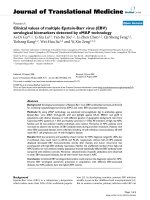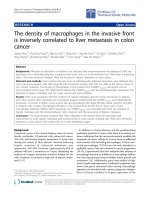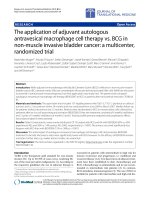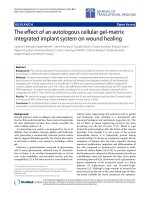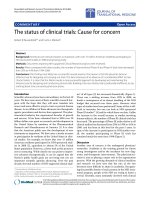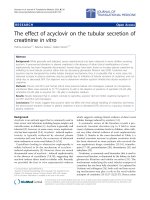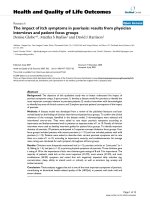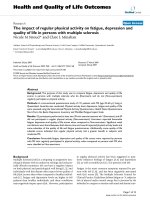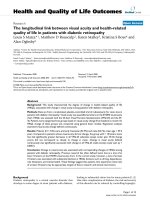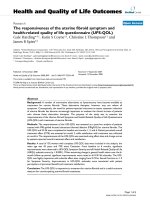báo cáo hóa học: " The burden of multiple sclerosis: A community health survey" pot
Bạn đang xem bản rút gọn của tài liệu. Xem và tải ngay bản đầy đủ của tài liệu tại đây (248.94 KB, 7 trang )
BioMed Central
Page 1 of 7
(page number not for citation purposes)
Health and Quality of Life Outcomes
Open Access
Research
The burden of multiple sclerosis: A community health survey
C Allyson Jones*
1,2
, Sheri L Pohar
2
, Sharon Warren
1
, Karen VL Turpin
3
and
Kenneth G Warren
3
Address:
1
Faculty of Rehabilitation Medicine, University of Alberta, Edmonton, Alberta, T6G 2G4, Canada,
2
Institute of Health Economics,
Edmonton, Alberta, T5J 3N4, Canada and
3
Faculty of Medicine and Dentistry, University of Alberta, Edmonton, Alberta, T6G 2G3, Canada
Email: C Allyson Jones* - ; Sheri L Pohar - ; Sharon Warren - ;
Karen VL Turpin - ; Kenneth G Warren -
* Corresponding author
Abstract
Background: Health-related quality of life (HRQL) in persons with multiple sclerosis (MS) who
reside within the community relative to the general population is largely unknown. Data from the
Canadian Community Health Survey Cycle 1.1 (CCHS 1.1) were used to compare HRQL of
persons with MS and the general population.
Methods: A representative sample of adults (18 years or older) from the cross sectional
population health survey, CCHS 1.1, was examined to compare scores on the Health Utilities Index
Mark 3 (HUI3), a generic preference-based HRQL measure, of respondents with (n = 302) and
without (n = 109,741) MS. Selected sociodemographic covariates were adjusted for in ANCOVA
models. Normalized sampling weights and bootstrap variance estimates were used in the analysis.
Results: The mean difference in overall HUI3 scores between respondents with and without MS
was 0.25 (95% CI: 0.20, 0.31); eight times greater than the clinically important difference. The
largest differences in scores were seen with the ambulation (0.26; 95% CI: 0.20, 0.32) and pain
attributes (0.14; 95% CI: 0.09, 0.19). Clinically important differences with dexterity and cognition
were also observed.
Conclusion: While the proportion of the Canadian population with MS is relatively small in
comparison to other diseases, the magnitude of the burden is severe relative to the general
population.
Background
The diverse symptoms associated with multiple sclerosis
(MS) adversely impact health-related quality of life
(HRQL) which, in turn, is manifested in extensive physi-
cal, psychosocial and economic burden [1-3]. Although
the assessment of HRQL in MS is well recognized as an
important clinical assessment tool [4], burden of morbid-
ity of persons with MS in comparison with the general
population is largely unknown.
The Expanded Disability Status Scale (EDSS) is the pri-
mary disease specific health measure for MS [5], but it is
heavily weighted toward ambulation and is unable to pro-
vide a broader comparison of HRQL attributes among dif-
ferent conditions and the general population. The use of a
generic health measure to complement the disease spe-
cific health measure is typically advocated for the
appraisal of the overall impact of MS.
Published: 7 January 2008
Health and Quality of Life Outcomes 2008, 6:1 doi:10.1186/1477-7525-6-1
Received: 25 July 2007
Accepted: 7 January 2008
This article is available from: />© 2008 Jones et al; licensee BioMed Central Ltd.
This is an Open Access article distributed under the terms of the Creative Commons Attribution License ( />),
which permits unrestricted use, distribution, and reproduction in any medium, provided the original work is properly cited.
Health and Quality of Life Outcomes 2008, 6:1 />Page 2 of 7
(page number not for citation purposes)
The evaluation of HRQL of persons with MS has been pri-
marily in clinical or patient study groups. Relying solely
on these cohorts limits the external validity of these find-
ings and generates possible selection bias [6]. Few investi-
gations have compared the burden of illness in MS to a
reference group or to the general population [7-10]. Sub-
sequently, only some studies have made comparisons by
statistically adjusting for differences between persons with
MS and a reference population. Limited evidence indi-
cates that physical attributes such as ambulation are lower
in persons with MS than the general population; however,
it is unclear whether other attributes such as pain and
emotion are relatively lower than the general population.
Using the SF-36, lower scores were reported for only phys-
ical dimensions in persons with MS as compared to the
US population; however, mental health scores were com-
parable to the general population [8]. Alternatively, both
physical and mental health components were lower for
patients with MS than the Norwegian general population
[7]. Others have reported problems with balance, cogni-
tion, visual disturbance, bowel and bladder difficulties,
spasticity, depression, anxiety, bipolar disorders, speech
problems and fatigue for persons with MS who reside
within the community [9,11,12].
The comparison of HRQL in the general population to a
sample of persons with MS provides quantitative baseline
estimates of the impact of MS which, in turn, can be used
for therapeutic intervention, program and healthcare eval-
uations. The primary aim of this study was to compare the
HRQL of persons who have MS to those persons without
MS, using a cross-sectional representative sample of the
general population. A secondary aim was to identify the
attributes associated with the burden of MS relative to the
general population adjusting for various socio-demo-
graphic factors. To assist in identifying the effect of MS
independent of other comorbidities, we also compared
the HRQL of persons with MS alone to the health status of
respondents without any chronic medical conditions.
Methods
Survey source
Data from the Canadian Community Health Survey Cycle
1.1 (CCHS 1.1) were used in this analysis. The CCHS 1.1
is a cross-sectional survey that collected data pertaining to
utilization of health services, determinants of health and
health status from 2000 to 2001 in the Canadian popula-
tion over age 12 [13]. All information collected in the
CCHS 1.1 was either self-reported or reported by a proxy
respondent. The survey excludes individuals living on
crown or reserve land, in institutions, members of the
Canadian Armed Forces and some remote areas of the
country, but still represents approximately 98% of the
Canadian population over 12 years of age [13].
A multistage stratified cluster design combined with ran-
dom sampling methods was used to select a representative
sample of the Canadian population [13]. Interviews could
be completed either in person or by telephone [14]. At the
end of Cycle 1.1 a total of 131, 535 respondents had been
surveyed; the overall response rate was 84.7% [14].
Approval to access the survey data was obtained from Sta-
tistics Canada and ethical approval was obtained through
the University of Alberta Health Research Ethics Board.
Sample
In the CCHS 1.1 respondents were asked to identify
chronic medical conditions that were diagnosed by a
healthcare professional and were or were expected to be
present for at least 6 months. A variety of chronic condi-
tions including MS were listed. Of the 131, 535 respond-
ents surveyed, 335 respondents reported having a
diagnosis of MS consistent with this definition. This pro-
portion represented a weighted percentage of 0.22% of
the community dwelling Canadian population over age
12 which is comparable to prevalence rates reported
[12,15]. The analysis was restricted to adult respondents
(18 years or older) who had complete data (n = 109,741
respondents without MS and n = 302 respondents with
MS).
Measures
The Health Utilities Index Mark 3 (HUI3), a generic pref-
erence-based measure was used to evaluate HRQL [16-
19]. The concept of the HUI is based on functional capac-
ity rather than performance. The HUI3 health states are
defined by eight attributes (vision, hearing, speech, ambu-
lation, dexterity, emotion, cognition and pain and dis-
comfort), with 5 or 6 levels of functioning for each
attribute. Single attribute utility scores for each of the
eight attributes range from 0.0 to 1.0, with a score of 0.0
representing the lowest level of functioning on an
attribute and a score of 1.0 representing full functional
capacity on an attribute. A difference of 0.05 on a single
attribute is considered to be clinically important [18]. For
descriptive purposes, classification systems are estab-
lished for aggregating attribute levels into none/mild
(0.89 to 1.00), moderate (0.70 to 0.88) and severe (less
than 0.70) [18]. The morbidity burden of a single
attribute can also be depicted by the distribution of per-
sons at each level.
An overall score for health states of the HUI3 is also gen-
erated which range from -0.36 to 1.0 (-0.36 = worst possi-
ble health, 0.0 = dead and 1.0 = perfect health). A
difference of 0.03 on overall HUI3 scores is considered to
be clinically important [18]. In order to assign meaning to
an average overall HUI3 scores, the scores can be grouped
into categories reflecting level of impairment: none/mild
Health and Quality of Life Outcomes 2008, 6:1 />Page 3 of 7
(page number not for citation purposes)
(0.89 to 1.00), moderate (0.70 to 0.88) and severe (less
than 0.70) [20].
The HUI3 has been used in both clinical and population
health studies [18]. It was originally developed for use in
the 1990 Ontario Health Survey conducted by Statistics
Canada and has subsequently been used for national pop-
ulation health surveys [18]. While other generic health
measures have reported floor and ceiling effects in MS
cohorts, the HUI3 has been reported to be robust in this
patient population [1,6,21].
Analysis
Descriptive statistics were used to summarize the charac-
teristics of the two groups, that is, respondents who
reported MS and those who did not. The sample sizes
reported are the actual observed numbers; however, the
reported percentages are weighted by the sampling
weights provided by Statistic Canada. The χ
2
value was
used for statistical comparison of proportions between
the two groups. Overall HUI3 scores and single attribute
scores of respondents with and without MS were then
compared using analysis of covariance (ANCOVA), with
adjustment for age, sex, education, marital status, social
assistance as a source of income, and number chronic
medical conditions other than MS [22-24]. As the propor-
tion of respondents who failed to report total household
income was large and would reduce the cohort, social
assistance was used as a marker of income.
To better capture the disease burden associated with MS
alone, a subgroup analysis was also performed, where the
health status of respondents with MS only (n = 60) and
respondents without MS or any other self-reported
chronic medical conditions was compared (n = 33,975
respondents). Differences in overall and single attribute
utility scores for these subgroups were also assessed using
ANCOVA, with adjustment for age, sex, education, marital
status, and social assistance as a source of income.
Sampling weights were applied to all analyses in order to
account for the unequal probability of being selected into
the survey [14]. Bootstrap variance estimates were used to
adjust for clustering and stratification [14] and to estimate
95% confidence intervals and p-values. Bootstrapping is a
technique to estimate the variance, that is, to approximate
the sampling distributions of the statistic. Repeated ran-
dom samples are drawn with replacement from the obser-
vations to obtain a set of estimates. All analyses were
performed using WESTVAR version 4.2, with bootstrap
weights provided by Statistics Canada.
Results
In this community-based population, respondents with
MS were approximately four years older on average than
the general population (48.7 versus 44.8 years of age, p <
0.05) (Table 1). A larger proportion of respondents with
MS than respondents without MS was female (68.3% ver-
sus 50.9%, p < 0.05). Unadjusted overall HUI3 scores
were considerably lower for respondents with MS (0.57
versus 0.88); this difference was more than 10 times that
would be considered clinically important (Table 1). Clin-
ically important differences were also seen with the single
attributes; MS respondents had lowers scores for ambula-
tion, dexterity, cognition and pain (Table 1).
After adjusting for the model covariates (age, sex, educa-
tion, marital status, and social assistance), clinically
important differences in overall HUI3 scores and single
attribute scores persisted. The mean difference in overall
HUI3 scores between respondents with and without MS
was reduced from 0.31 to 0.25 after adjustments (95%
confidence interval (CI): 0.20 to 0.31, p < 0.05) (Table 2).
This difference, however, was still more than eight times
what would be considered clinically important. On the
single attributes, a difference of 0.05 is considered clini-
cally meaningful. Particularly large differences in scores
were observed for ambulation and pain, with differences
of 0.26 (95% CI: 0.20 to 0.32, p < 0.05) and 0.14 (95%
CI: 0.09 to 0.19, p < 0.05), being observed, respectively.
Clinically important differences on the dexterity and cog-
nition attributes were also observed, although differences
were not as large as those observed for ambulation and
pain (Table 2). No clinical differences were seen with sen-
sory and emotion attributes.
When persons with MS alone were compared to persons
without MS or any other chronic conditions, differences
in overall and single attribute utility scores were similar to
those observed in the entire sample (Table 3). The differ-
ence in overall HUI3 scores between the subgroups with-
out any chronic conditions was 0.29 (95% CI: 0.18 to
0.41, p < 0.05) (Table 3). Again, the largest differences on
the single attributes were observed for ambulation and
pain (Table 3). Clinically important differences were also
observed on the dexterity and cognition attributes.
Discussion
Within the context of a national population health survey,
the burden of illness for persons with MS was quantified
using a generic health measure, HUI3 in the community
dwelling population. We found that the MS population
experienced large deficits in overall HRQL relative to the
general population without MS. When the effect of other
chronic conditions was removed, persistent large deficits
of HRQL existed for persons with MS. Given the underly-
ing neuropathologic changes that occur to the central
nervous system and the diverse clinical features, it is not
surprising that HRQL would be affected by the disease. In
particular, our findings quantify significant difficulties
Health and Quality of Life Outcomes 2008, 6:1 />Page 4 of 7
(page number not for citation purposes)
with pain, ambulation, dexterity, and cognition in per-
sons with MS.
Our findings were similar to other population samples. A
Norwegian community-based cohort reported lower
health status in persons with MS compared to the general
population [7]. Findings from a cross sectional survey also
reported lower physical functioning, vitality, general
health and psychological domains in MS patients than
controls [25,26]. An association between MS and mental
health has been also reported within other population-
based samples [12,27]. Although SF-36 physical compo-
nent scores in persons with MS were lower in comparison
to the US population, the mental component scores were
similar to the general population [8]. This divergence
from other studies may be attributable, in part, to psycho-
metric properties of the components scores for the SF-36.
Orthogonal factor rotation is used in the determination of
the SF-36 component scores, that is, mental and physical
components scores are treated as independent. Subse-
quently, the algorithm has been shown to significantly
under-estimate mental health of patients with MS as com-
pared to the component scores based on the RAND-36
Health Status Inventory [28].
While the prevalence of pain in MS is well recognized, the
severity relative to the general population has been exam-
ined by few investigators [29]. We reported large differ-
ences in pain for both unadjusted and adjusted analysis.
The difference between the MS and general population
while adjusting for other covariates was almost five times
that would be considered clinically important. Others
Table 2: Adjusted† mean scores and differences in overall and single attribute utility scores for respondents with and without MS
MS General Population Mean Difference (95% CI)
Overall HUI3 score 0.58 0.84 0.25 (0.20 – 0.31)*
Vision 0.94 0.96 0.03 (0.01 – 0.05)*
Hearing 0.99 0.99 0.00 (-0.01 – 0.004)
Speech 0.99 1.00 0.01 (-0.003 – 0.006)
Ambulation 0.72 0.98 0.26 (0.20 – 0.32)*
Dexterity 0.93 1.00 0.06 (0.03 – 0.10)*
Emotion 0.92 0.95 0.03 (0.01 – 0.05)*
Cognition 0.89 0.94 0.05 (0.02 – 0.09)*
Pain 0.77 0.91 0.14 (0.09 – 0.19)*
† Adjusted for age, sex, education, marital status, social assistance, and number of medical conditions other than MS
* p < 0.05 based on the Bootstrap Variance Estimate for between groups difference after adjusting for covariates.
Table 1: Demographic characteristics
MS General Population
Age – mean (95% CI) 48.7 (46.6 to 50.8)* 44.8 (44.7 to 44.8)
Sex (% Female) 68.3* 50.9
Education – %
Less than high school 17.9 22.2
High School 19.0 20.4
Some post-secondary/college/trade school 42.9 36.5
University degree 20.1 20.9
Marital Status (% Married) 71.0 64.3
Social Assistance (% Receiving Social Assistance) 11.1* 5.1
Number of other Medical Conditions mean (95% CI) 2.6 (2.3 to 3.0)* 1.6 (1.6 to 1.6)
HUI3 Scores – mean (95% CI)†
Overall HUI3 score 0.57 (0.52 to 0.63)* 0.88 (0.88 to 0.88)
Vision 0.93 (0.91 to 0.95)* 0.97 (0.97 to 0.97)
Hearing 0.99 (0.98 to 0.99) 0.99 (0.99 to 0.99)
Speech 0.99 (0.99 to 0.99) 1.00 (0.99 to 1.00)
Ambulation 0.71 (0.65 to 0.77)* 0.98 (0.98 to 0.98)
Dexterity 0.93 (0.90 to 0.96)* 1.00 (1.00 to 1.00)
Emotion 0.93 (0.91 to 0.95)* 0.97 (0.97 to 0.97)
Cognition 0.89 (0.86 to 0.92)* 0.96 (0.96 to 0.96)
Pain 0.75 (0.69 to 0.80)* 0.93 (0.93 to 0.93)
* p < 0.05
† HUI3 classification systems for overall and attribute levels: none/mild (0.89 to 1.00), moderate (0.70 to 0.88) and severe (less than 0.70).
Health and Quality of Life Outcomes 2008, 6:1 />Page 5 of 7
(page number not for citation purposes)
have recognized acute and chronic pain in this patient
population as a substantial clinical problem [29-31],
while others have not [7,8]. Congruent with our findings,
Svendsen and colleagues reported that the severity of pain
is greater in persons with MS than the general population
[29]. The ramifications of pain are also far reaching given
the associations with depression, fatigue, and poorer
health status [30,32]. The assessment and treatment of
pain warrants further consideration in this patient popu-
lation which may directly improve HRQL.
The HRQL of persons with MS reported in this study illus-
trates that the HRQL is worse than HRQL reported with
many other diseases. Maddigan and colleagues reported
the overall HUI3 score for persons with diabetes, heart
disease, arthritis or stroke ranged from 0.74 to 0.89 [22].
Moreover, the overall HUI3 scores of various combina-
tions using three of these four conditions still ranged from
0.62 to 0.66 [22]. In relative terms, one may conclude that
the HRQL of burden associated with MS is substantially
higher than any one of these four other chronic condi-
tions or in any combination of three of these four condi-
tions. Others have also reported that patients with MS are
among one of the most severely impaired in comparison
with other chronic conditions such as cardiovascular con-
ditions, cancer, endocrinologic conditions, and chronic
respiratory diseases [6,33]. This illustrates the severe
impairment that is associated with MS, even among com-
munity dwelling individuals with the disease.
Although secondary analysis makes use of valuable data,
the limitations of these findings are noteworthy. First,
ascertainment of MS was via self-report. Although ques-
tions regarding the presence of medical conditions speci-
fied that the condition was diagnosed by a health
professional, there remained potential for individuals to
over- or under-report any medical condition, including
MS. Likewise, no disease specific health measure for MS or
indicator for disease course was included in the CCHS 1.1.
Another limitation of this study concerned the number of
respondents who were missing data on covariates and
were excluded from the analysis. While this was less than
10.0% of MS respondents, generalizability of these results
to the respondents with missing data may be limited.
Despite over 98% of the Canadian community dwelling
population being represented in the survey, the generaliz-
ability of the results to the entire Canadian population
with MS is limited by the fact that the sampling frame
would not capture those individuals who reside in institu-
tions or on reserve lands. That being said, the true HRQL
burden of the entire Canadian population with MS would
be under-estimated by these results given that individuals
with MS who resided in institutions were more likely to
have greater impairment than those residing in the com-
munity. Although the impact of MS appears to be more
severe in First Nations People, the prevalence rates of MS
are relatively low [34] and would likely have a small
impact on the overall HRQL of this sample population.
Conclusion
These findings highlight the severity of impairment
expressed by persons with MS relative to the general pop-
ulation and when compared to other chronic conditions.
While the proportion of persons with MS may be rela-
tively small in relation to the Canadian population, the
issue of HRQL in MS patients is important from clinical
practice and policy decision perspectives. These findings,
which identify the diverse impairment and quantify the
amount of disability persons with MS, can be used when
evaluating therapeutic interventions and healthcare pro-
grams.
Table 3: Adjusted† mean scores and differences in overall and single attribute utility scores for respondents with and without MS, but
no other chronic conditions
MS General Population Mean Difference (95% CI)
Overall HUI3 score 0.64 0.93 0.29 (0.18 to 0.41)*
Vision 0.95 0.98 0.03 (-0.01 to 0.07)*
Hearing 1.00 0.99 0.00 (0.00 to -0.01)
Speech 0.99 1.00 0.00 (-0.01 to 0.02)
Ambulation 0.69 1.00 0.31 (0.17 to 0.44)*
Dexterity 0.95 1.00 0.05 (-0.01 to 0.11)
Emotion 0.93 0.97 0.04 (-0.01 to 0.09)*
Cognition 0.88 0.97 0.09 (0.02 to 0.16)*
Pain 0.88 1.00 0.11 (0.03 to 0.20)*
† Adjusted for age, sex, education, marital status, and social assistance
* p < 0.05 based on the Bootstrap Variance Estimate for between groups difference after adjusting for covariates.
Health and Quality of Life Outcomes 2008, 6:1 />Page 6 of 7
(page number not for citation purposes)
Abbreviations
HRQL: Health-related quality of life;
MS: multiple sclerosis;
CCHS 1.1: Canadian Community Health Survey Cycle
1.1;
HUI3: Health Utilities Index Mark 3;
ANCOVA: analysis of covariance;
95%CI: 95% confidence interval;
EDSS: Expanded Disability Status Scale.
Competing interests
The author(s) declare that they have no competing inter-
ests.
Authors' contributions
Drs Jones and Pohar were responsible for the conception
of the study. Dr. Pohar analyzed the data. Dr. Jones
drafted the article. All authors contributed to the interpre-
tation of the results and revising the article for important
intellectual content. All authors read and approved the
final manuscript.
Acknowledgements
The research and analysis are based on data from Statistics Canada. The
opinions expressed do not represent the views of Statistics Canada. We
also express our gratitude to Dr. D.H. Feeny for his constructive com-
ments.
References
1. Mitchell AJ, Benito-Leon J, Gonzalez JM, Rivera-Navarro J: Quality of
life and its assessment in multiple sclerosis: integrating phys-
ical and psychological components of wellbeing. Lancet Neurol
2005, 4:556-566.
2. Patwardhan MB, Matchar DB, Samsa GP, McCrory DC, Williams RG,
Li TT: Cost of multiple sclerosis by level of disability: a review
of literature. Mult Scler 2005, 11:232-239.
3. Burden of illness of multiple sclerosis: Part I: Cost of illness.
The Canadian Burden of Illness Study Group. Can J Neurol Sci
1998, 25:23-30.
4. Vickrey BG, Hays RD, Genovese BJ, Myers LW, Ellison GW: Com-
parison of a generic to disease-targeted health-related qual-
ity-of-life measures for multiple sclerosis. J Clin Epidemiol 1997,
50:557-569.
5. Kurtzke JF: Rating neurologic impairment in multiple sclero-
sis: an expanded disability status scale (EDSS). Neurology 1983,
33:1444-1452.
6. Burden of illness of multiple sclerosis: Part II: Quality of life.
The Canadian Burden of Illness Study Group. Can J Neurol Sci
1998, 25:31-38.
7. Nortvedt MW, Riise T, Myhr KM, Nyland HI: Quality of life in mul-
tiple sclerosis: measuring the disease effects more broadly.
Neurology 1999, 53:1098-1103.
8. Pittock SJ, Mayr WT, McClelland RL, Jorgensen NW, Weigand SD,
Noseworthy JH, Rodriguez M: Quality of life is favorable for
most patients with multiple sclerosis: a population-based
cohort study. Arch Neurol 2004, 61:679-686.
9. Ford HL, Gerry E, Johnson MH, Tennant A: Health status and
quality of life of people with multiple sclerosis. Disabil Rehabil
2001, 23:516-521.
10. Minden SL, Frankel D, Hadden LS, Srinath KP, Perloff JN: Disability
in elderly people with multiple sclerosis: An analysis of base-
line data from the Sonya Slifka Longitudinal Multiple Sclero-
sis Study. NeuroRehabilitation 2004, 19:
55-67.
11. Roessler RT, Rumrill PD Jr., Hennessey ML, Vierstra C, Pugsley E,
Pittman A: Perceived strengths and weaknesses in employ-
ment policies and services among people with multiple scle-
rosis: results of a national survey. Work 2003, 21:25-36.
12. Patten SB, Svenson LW, Metz LM: Descriptive epidemiology of
affective disorders in multiple sclerosis. CNS Spectr 2005,
10:365-371.
13. Beland Y: Canadian community health survey methodologi-
cal overview. Health Rep 2002, 13:9-14.
14. Canada S: CCHS Cycle 1.1, Public Use Microdata File Docu-
mentation. 2004.
15. Rosati G: The prevalence of multiple sclerosis in the world: an
update. Neurol Sci 2001, 22:117-139.
16. Feeny DH, Torrance GW, Furlong WJ: Health Utilities Index. In
Quality of Life and Pharmacoeconomics in Clinical Trials 2nd edition.
Edited by: Spilker B. Philadelphia, Lippincott-Raven Publishers;
1996:239-252.
17. Furlong W, Feeny D, Torrance GW, Goldsmith C, Depauw S, Boyle
M, Denton M, Zhu Z: Multiplicative Multi-attribute Utility
Function for the Health Utilities Index Mark 3 (HUI3) Sys-
tem: A technical Report. Volume 98-11. McMaster University
Centre for Health Economics and Policy Analysis Working Paper;
1998.
18. Horsman J, Furlong W, Feeny D, Torrance G: The Health Utilities
Index (HUI(R)): concepts, measurement properties and
applications. Health Qual Life Outcomes 2003, 1:54.
19. Feeny D, Furlong W, Torrance GW, Goldsmith CH, Zhu Z, Depauw
S, Denton M, Boyle M: Multiattribute and single-attribute util-
ity functions for the health utilities index mark 3 system. Med
Care 2002, 40:113-128.
20. Inc HU: 2004 [
]. Accessed August 20,
2004.
21. Fisk JD, Brown MG, Sketris IS, Metz LM, Murray TJ, Stadnyk KJ: A
comparison of health utility measures for the evaluation of
multiple sclerosis treatments. J Neurol Neurosurg Psychiatry 2005,
76:58-63.
22. Maddigan SL, Feeny DH, Johnson JA: Health-related quality of life
deficits associated with diabetes and comorbidities in a
Canadian National Population Health Survey. Qual Life Res
2005, 14:1311-1320.
23. Grootendorst P, Feeny D, Furlong W: Health Utilities Index
Mark 3: evidence of construct validity for stroke and arthritis
in a population health survey. Med Care 2000, 38:290-299.
24. Evans RG, Stoddart GL: Producing health, consuming health
care. Soc Sci Med 1990, 31:1347-1363.
25. Murphy N, Confavreux C, Haas J, Konig N, Roullet E, Sailer M, Swash
M, Young C, Merot JL: Quality of life in multiple sclerosis in
France, Germany, and the United Kingdom. Cost of Multiple
Sclerosis Study Group. J Neurol Neurosurg Psychiatry 1998,
65:460-466.
26. Rothwell PM, McDowell Z, Wong CK, Dorman PJ: Doctors and
patients don't agree: cross sectional study of patients' and
doctors' perceptions and assessments of disability in multi-
ple sclerosis. BMJ 1997, 314:1580-1583.
27. Patten SB, Beck CA, Williams JV, Barbui C, Metz LM: Major depres-
sion in multiple sclerosis: a population-based perspective.
Neurology 2003, 61:1524-1527.
28. Nortvedt MW, Riise T, Myhr KM, Nyland HI: Performance of the
SF-36, SF-12, and RAND-36 summary scales in a multiple
sclerosis population. Med Care 2000, 38:1022-1028.
29. Svendsen KB, Jensen TS, Overvad K, Hansen HJ, Koch-Henriksen N,
Bach FW: Pain in patients with multiple sclerosis: a popula-
tion-based study. Arch Neurol 2003, 60:1089-1094.
30. Ehde DM, Gibbons LE, Chwastiak L, Bombardier CH, Sullivan MD,
Kraft GH: Chronic pain in a large community sample of per-
sons with multiple sclerosis. Mult Scler 2003, 9:
605-611.
31. Goldman MD, Cohen JA, Fox RJ, Bethoux FA: Multiple sclerosis:
treating symptoms, and other general medical issues. Cleve
Clin J Med 2006, 73:177-186.
Publish with BioMed Central and every
scientist can read your work free of charge
"BioMed Central will be the most significant development for
disseminating the results of biomedical research in our lifetime."
Sir Paul Nurse, Cancer Research UK
Your research papers will be:
available free of charge to the entire biomedical community
peer reviewed and published immediately upon acceptance
cited in PubMed and archived on PubMed Central
yours — you keep the copyright
Submit your manuscript here:
/>BioMedcentral
Health and Quality of Life Outcomes 2008, 6:1 />Page 7 of 7
(page number not for citation purposes)
32. Kalia LV, O'Connor PW: Severity of chronic pain and its rela-
tionship to quality of life in multiple sclerosis. Mult Scler 2005,
11:322-327.
33. Sprangers MA, de Regt EB, Andries F, van Agt HM, Bijl RV, de Boer
JB, Foets M, Hoeymans N, Jacobs AE, Kempen GI, Miedema HS,
Tijhuis MA, de Haes HC: Which chronic conditions are associ-
ated with better or poorer quality of life? J Clin Epidemiol 2000,
53:895-907.
34. Svenson LW, Warren S, Warren KG, Metz LM, Patten SB, Schopflo-
cher DP: Prevalence of multiple sclerosis in First Nations peo-
ple of Alberta. Can J Neurol Sci 2007, 34:175-180.
